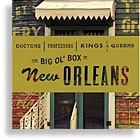
The music of New Orleans has, by now, been over-anthologized, but, with four discs and an 80-page book, Shout! Factory’s deluxe treatment is perhaps the most ambitious to date, and quite possibly the most fun.
Since this is not a “jazz” or “rhythm and blues” anthology, producer/compiler Chuck Taggart’s task was to distill the city’s varied sounds into a mere 84 tracks, clocking in at five-and-a-quarter hours. Taggart, a NOLA expatriate and deejay at KCSN in Los Angeles, says his instruction from label head Gary Stewart was to make a party record – so he wisely took a shotgun approach to sequencing, stirring up genres and eras. If you want a history lesson, go to the library; if you want to experience New Orleans, this shuffle-button approach is like walking past a block of clubs, hearing different styles fade in, fade out, and sometimes overlap.
Taggart does, however, detail the history behind the sounds in his informative narrative in the book, which is interwoven with vignettes about the city’s sights, smells and tastes by Mary Herczog (whose byline was inadvertently omitted in the layout process). Extensive session information is also included for each cut, so we find out, for instance, who played guitar on Frankie Ford’s 1959 hit “Sea Cruise.”
So what’s to complain about? Well, I’d hardly be a self-respecting music journalist if I didn’t question a compilation’s inclusions and omissions. But it’s really just niggling – probably because I wish I’d gotten the gig instead of Taggart. It’s like Herczog (and, admittedly, most people) preferring the Central Grocery’s muffuletta. I’ll take the Napoleon House’s over it any day – while sipping a Pimm’s Cup with a slice of cucumber.
New Orleans’ musical scope is already vast, but Doctors, Professors is even broader – encompassing, for instance, Cajun music and zydeco. From a marketing standpoint, this makes sense. I can almost hear readers thinking, “Yeah, zydeco, blackened redfish – that’s New Orleans.” But South Louisiana is made up of a plethora of regional scenes, and Cajun and zydeco hail from Lafayette, Opelousas, and Lake Charles – three to four hours’ drive from the Crescent City. That’s like lumping Houston or Dallas into a survey of Austin music, or treating Nashville and Memphis as one and the same.
The fact is, Cajun and zydeco have grown increasingly popular in the Big Easy – but where haven’t they? The problem is, as great as material by BeauSoleil and Boozoo Chavis is, it takes up space that could have been occupied by indigenous, how-could-they-leave-out artists – like Esquerita, Astral Project, Louis Prima, and Sam Butera. My only other quibbles are that, with such tough decisions, anything remotely so-so (like J. Monque’D) need not apply, and (title aside) “No City Like New Orleans” isn’t representative of Earl King’s best work.
King is one of the guitarists who stands out in a scene dominated by pianos, horns and drums; others represented here include Sonny Landreth, Gatemouth Brown, Leo Nocentelli (and bass wonder George Porter) of the Meters, Snooks Eaglin, and Deacon John (both as a solo artist and as sideman on classics by Aaron Neville, Benny Spellman, and Ernie K-Doe).
But what’s the answer to our trivia question? The guitarist on “Sea Cruise” was none other than Mac Rebennack, better known as Dr. John, a mere 18-year-old “sprout,” to use one of his own terms, at the time. Ooh wee, baby, indeed! – DF
This article originally appeared in VG‘s March ’05 issue. All copyrights are by the author and Vintage Guitar magazine. Unauthorized replication or use is strictly prohibited.

